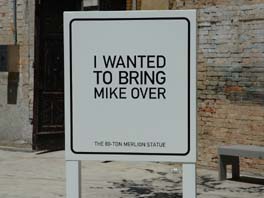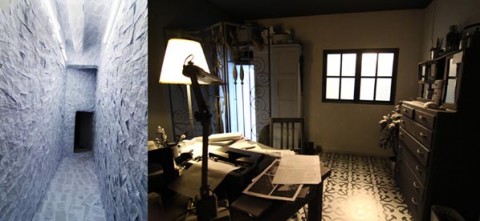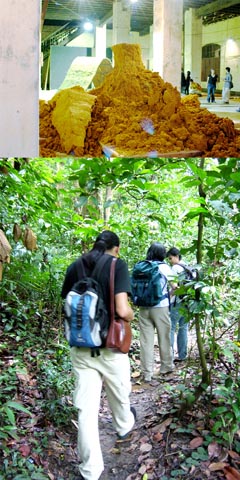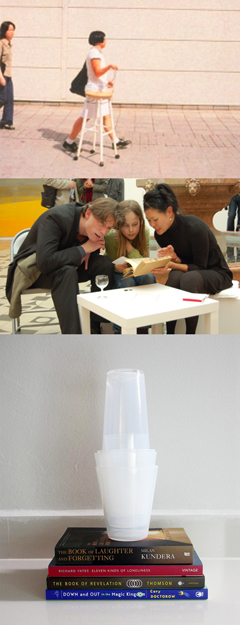
Lifeblood (2009), Twardzik Ching, Acrylic tank, PVC pipes, wooden staircase and Singapore River water
This post/observation comes a little belatedly, given that the voting for this year’s President’s Young Talents has just ended. This means of employing the popular vote to determine the winner of the People’s Choice Award is a first for the biennial event since its inauguration in 2001. Incidentally, this year’s exhibition also marks the first time a single artist or collective will be identified as an official winner of the showcase and leave with a bag of cash and a sponsored overseas residency.
I’ve always been a little perturbed by the introduction of competitive elements in an exhibition of contemporary art. And the notion of designating a singular, absolute winner becomes all the more unsettling given the context of a national, state-endorsed artistic talent showcase. The President’s Young Talents (PYT) Exhibition, fortunately or unfortunately, is not the Singaporean equivalent of Britain’s Turner Prize. Affixed to its name is the austere regality of the presidential label, which has also made its cameos at other high-profile national awards and events. The risk here, naturally, is the creation of a national prescription for cultural tastes which is in essence antithetical to the nature of contemporary art in which alterity, criticality and multiplicity are its defining hallmarks.
Such concerns can be said to be the result of my slightly overwrought imagination, since PYT, despite the state endorsement, thankfully does not wield that much influence as a legislator of cultural taste. And if we are to put aside our prejudices towards state-supported artistic fanfare, the works at this year’s PYT are really not as commercialised and ostentatious as feared. In fact, the works by Donna Ong, Felicia Low, Twardzik Ching and Vertical Submarine collectively form a respectable sample of contemporary art in Singapore that reflect and enrich the established discourses surrounding “contemporaneity” in Singapore art.
Locating the Contemporary in Singapore Art
In Contemporary Art in Singapore, the seminal publication by Gunalan Nadarajan, Russell Storer and Eugene Tan, a particular comment on the unique contemporary nature of Singapore by Dutch architect Rem Koolhaas is highlighted.
Almost all of Singapore is less than 30 years old; the city represents the ideological production of the past three decades in its pure form, uncontaminated by surviving contextual remnants. It is managed by a regime that has excluded accident and randomness: even its nature is entirely remade. It is pure intention: if there is chaos, it is authoredchaos; if it is ugly, it is designed ugliness; if it is absurd, it is willedabsurdity. Singapore represents a unique ecology of the contemporary.
There is much truth that holds in Koolhaas’ observations of our neatly pruned bonsai city. For authored chaos, check out the Swing Singapore mass parties. For designed ugliness, there’s our national mutant, the Merlion. And as for willed absurdity, we have bar-top dancing. But even within a tightly controlled cultural climate where the vagaries of spontaneity are quickly suppressed, a sense of the contemporary can emerge. As Eugene Tan elaborates, art in Singapore rarely presents itself as “overt forms of political protests”, but functions primarily through the adoption of “conceptualist strategies” and “institutional critique”.
These dual strategies of conceptualism and institutional critique are strikingly visible in the works of the represented artists at this year’s PYT. The fact that some of the artists also exhibit their previous works within their gallery spaces, creating a miniature retrospective of their works, also help largely in creating a broader conciousness of the kind of artistic frameworks they, as well as their contemporaries, are working within.
A Localised Conceptualism
Conceptualism in the West in the 1970s had left an indelible mark upon Singapore contemporary art and its influence persists till today. Evolving within the stranglehold of a culture averse to uncertainty and adventurism, as well as a lack of official funding, conceptualism in Singapore has emerged out of an economy of means and developed via the strategies of dematerialisation, deformalisation and improvisation. It keeps itself understated, unstructured and unspectacular, modelling itself based on everyday activities of walking, chatting, eating, drinking, reading and… stacking.
Conceptualism in Singapore: (from top) Amanda Heng walks the chair in Let’s Walk (1999), Lynn Lu practises fortune-telling by reading from the I Ching in A Guide to Life’s Turning Points (2009) and Heman Chong attempts the art of stacking in Stacking (2009)
Felicia Low’s performance workshops in The Stimulus and the Conversation has its local roots in the workshops of performance artists such as Tang Da Wu during the infancy of contemporary art in Singapore. The conceptualist positioning of these artworks as “workshops”, or as innocuous everyday events were effective strategies at their deformalisation, as a means to avoid the unnecessary state intervention and sensationalistic press coverage that the official designation of “performance art” invites.
Also of interest is the communal and collaborative nature of Low’s art-making process, which aligns her works with the social sculptures of Joseph Beuys as well as the do-it-yourself installations of Sol LeWitt, in which the artist leaves a set of written prosaic instructions for his audience to create the artwork. But Low’s approach is pedagogical, not instructional. Her background in arts education enables her to work more collaboratively with her audiences without any differentiation in status between the artist and her audience. The sense of experimentation, spontaneity and diversity is consequently more evident in the creative products that emerge from her workshops.
Like the conceptualist artists of the West, the informal, time-specific and site-specific nature of the works also mean that the public can only know about them through documentation in the form of photographs, written texts, recordings or performance artifacts. Low’s works also manifests such a symptom, as her gallery space is effectively a showcase of the physical remnants of her performances.
The issues explored by some of the represented artists, remarkably, also reflect that most of them, whether consciously or unconsciously, are largely operating within a conceptualist paradigm. Issues of the artifactual nature of the art object, as explored by Low, as well as the relationship between text, image and object as examined by Vertical Submarine’s A View with a Room, are notably the constant fixations of the conceptual art movement between the 1960s to 80s.
Inevitably, it does seem to me that the conceptual art movement as well as its subsequent manifestations has been deeply ingrained into local art and subsequently led to the emergence of a localised variant under a particular socio-political landscape. Initial manifestations of this local variant continue to resurface today, in forms such as Low’s performance workshops, in which authored banality, designedinformality and willed simplicity are its defining characteristics. But evidently the field today has largely diversified with the nation’s cautious and gradual liberalisation, creating room for conceptual works such as Vertical Submarine’s elaborate installations, which are undeniably louder, bolder and much more complex.
Institutional Critique as Political Gesture
Alongside with conceptualist strategies, institutional critique, defined as a work’s engagement with the institutional structures of art and power that governs it, has become representative of local contemporary art. Given that explicit forms of political protests are bound to raise the alarm for state intervention, political discontent is often expressed as an undercurrent, securely under the guise of the meta-discourse of institutional critique.
Twardzik Ching’s ambitious endeavour in Lifeblood to pump water directly from Singapore river to her gallery at 8Q is immediately reminiscent of one of Singapore’s most emblematic works of institutional critique – Lim Tzay Chuen’s audacious and foolhardy proposal to relocate the eight-metre tall, 70-tonne Merlion sculpture to the 51st Venice Biennale in 2005. What a storm it would have started if he had aimed for the bigger fish at Sentosa.
The bureaucratic obstacles faced by Lim is mirrored in the case of Ching’s work and both artists failed to achieve their original intentions. The eventual work that is exhibited at 8Q is a compromise – the water is not pumped directly from the river, but instead transported from the river by vehicles that deposit it into a water tank installation at the 8Q courtyard to be piped up to the gallery. The artist laments that the entire project took six months to materialise, a result not of the work’s physical complexity, but of the impenetrable layers of bureaucracy imposed by the government’s network of statutory boards.

Mike (2005), Lim Tzay Chuen, Singapore Pavillion at the 51st Venice Biennale
In comparison, Lim’s attempt to take our national icon on a holiday did not even result in a compromise. Represented at the biennial instead was a sign that deadpans, “I wanted to bring Mike over”. It may appear a little appalling how this apparent debasing of a state-created national icon can gain the official support to be exhibited at one of the most prestigious international art events. The comparative ease with which Lim sneaked in political commentary into the Venice Biennale can be attributed to the positioning of the work as a form of institutional critique.
Lim’s works have been known to engage in the most questionable and absurd forms of institutional critique even prior to Mike. In an earlier project, Lim presented an eventually rejected proposal to UOB to slightly rotate Salvador Dali’s Homage to Newton, located in front of the UOB building, and subsequently rotate it back to its original position a year later as an artistic “intervention”. Likewise, Mike was positioned as an institutional critique into the workings of biennales and the associated issues of national representation at such events.
Essentially, institutional critique is a profoundly political gesture. But it manages to evade the grip of the censorial society by apparently confining its politics to that of the art world. By positioning itself as a self-reflexive meta-discourse, concerned with the seemingly parochial issues exclusive to the realm of art, it appears less of a threat to the national order as compared to explicit and specific political works. But of course, the reality is that the politics of the art realm can never be divorced from the politics of government and society. Works that are positioned as examinations into the systems of the art world inevitably reflect that tensions and anxieties that characterise the larger society.
In this light, Mike was not just a critique of the politics of national representation at biennales, but of a state’s anxieties towards its own projected image. After all, the Merlion was a deliberately constructed national icon that originated as the logo for the Singapore Tourism Board. It effectively started out as nothing more than an economic apparatus.

Robert Smithson’s Spiral Jetty (1970)
Likewise, while many of Ching’s public land art projects are deliberately designed to contest artistic traditions and to exist beyond the institution of the museum, their concerns also lie beyond the ideologies of the white cube and the art world. Works such as Landing Space,Borrowed Nature as well as Lifebloodmay ostensibly bear immediate affiliation to the land art projects of Robert Smithson or Walter De Maria, but they also concern themselves with the broader social-cultural issues of national identity and our emotional estrangement from our physical land, that effectively represents the symbolic nation. Under the guise of institutional critique, Ching has actually managed to put forth a deeply political statement on our national identity crisis. Her works powerfully highlight how our concept of nationhood is so perilously tenuous that it seems impossible to conceive of a notion of “Singapore” beyond its physical land. Is Singapore no more than the sum of its geography?
This can similarly be observed for the projects of Vertical Submarine, particularly with their work created for PYT, A View with a Room. Their installation setup is particularly peculiar as the eponymous room is deliberately concealed from the view of the audience. Instead, the visitor has to open a closet, enter it and walk through a passage covered with paper to reach the installation. The uninformed and unadventurous visitor that dogmatically refrains from touching museum objects would thus never experience the serendipity of discovering the hidden installation. In this light, the work is an intriguing critique of the norms of museum-going, where interactivity and a sense of adventure is suppressed by established codes of conduct.

Moving from one installation into another: (from left) Paper Room (2003) and A View with a Room (2009), both by Vertical Submarine
A View with a Room, aside from its primary concern with regards to the relationship between text and image, is most explicitly a form of institutional critique towards our social conduct within the sanctum of museum spaces. But as with Twardzik Ching’s and Lim Tzay Chuen’s works, the work’s subject of critique extends beyond the realm of art – it is effectively a critique of a socio-political culture that is essentially averse to any forms of subversion, where even the most tacit of social rules have evolved into dogma.
Beyond the Contemporary

Twardzik Ching’s previous land art projects include Landing Space (2002) (top) and Borrowed Nature (2003) (bottom)
As I’ve attempted to illustrate in relation to the representative sample of contemporary art at this year’s PYT and as previously articulated by Eugene Tan, contemporary art in Singapore today seems to adopt “conceptualist strategies” and “institutional critique” as its defining hallmarks.
These dual strategies appear to be the most viable modes of subversion within a tightly controlled field of cultural production, because they enable artists to avoid the problematic label of being “Political”, with the capital “P”. But of course, these identified strategies are by no means permanent or representative of all forms of contemporary art in Singapore, particularly given the constantly evolving and diversifying state of art and the social and cultural forces that shape it.
Perhaps many artists are uncomfortable with the notion of grouping their works according to specific categories or movements. But the truth is that the artist is never a free vagabond roaming an unpolluted realm of cultural freedom. They are often susceptible to the broader institutional forces that drive the art world, whether or not to their conscious knowledge. Identifying and validating these broad trends in local contemporary art are, in fact, essential to our understanding of the places that art in Singapore is heading towards, or of whether it is actually heading anywhere at all.
The President’s Young Talents Exhibition is currently on display at SAM at 8Q from 15 August to 27 December 2009. Usual admission charges apply.
~
Ho Rui An is an independent filmmaker, artist and writer from Singapore. He publishes his writings on the arts, culture and society on his weblog,http://opencontours.wordpress.com.



Shall we compare this to the Malaysian version?
HI THERE YANG DIHORMATI,
1. SEBELUM KITA MENYENTUH ISU TENTANG PERBANDINGAN, WHAT DID YOU MEANT BY “MALAYSIAN VERSION”? BMS, MEA OR…?
2. DARI SEGI MANA PULAK THIS TWO AWARDS YANG DIMAKSUDKAN CAN BE COMPARED…DARI SEGI SERIOUSNESS MENGENAI THE WAY OF PRESENTING ARTWORKS AND JUDGING PROCESS, OR, KEBAIKAN DARI SEGI MATERIAL, SETELAH SESEORANG SENIMAN MUDA DIANUGERAHI?
I’m referring to the current Malaysian art prize featured recently on Arteri. How about let’s start with the artworks themselves?
hmm pendapat saya klu nk bandingkan…maka bykla Malaysia dpt kosong..atau sebaliknya…hmm
Koolhaas speaks about Singapore’s regimented architecture and society so derivesively but he gives into this “authored order & chaos”.
Instead of offering hopeful alternatives (maybe which I am just ignorant of) he joins in with the rest of the most absurdist and greedy architects of the world to terraforming Dubai into the most hypocritical, cynical, ridonkulous form of modern city, filled to the brim with technology and glamore but runned by medieval society profitting from to the irresponsible rich and exploiting foreign labourers.
Well, gotta say that he atleast made it funny by designing his project in the form of the Death Star.
Hello Wasup,
Actually I think Koolhaas’s derision was pretty much the beginning of this strain of uncritical reading that has been parroted so often today that it has often filtered our experience of Singapore.
Authored chaos is not exactly how I would come to describe many pocket communities around Singapore from little India to Geylang. The term is wayyy too deterministic. I am guilty of quoting Koolhass in the past in regards to Singapore which I feel shameful of now.
I think there is an element of truth in the way development in Singapore is engineered that reflects his statement but I doubt he has that kind of facility to understand or speak to Singaporeans enough, especially those from outside of the professional class, that might offer a more multilayered experience of the island nation. Ironically, isn’t that what Koolhaas does best, as of most architects with Monocle aspirations? Authoring context into his structure so that it gives it and ordered semblance of historicity??
– simon
Frankly, I’ve only read bits of this guy and quick impression of his monolithic design makes me think he has issues with a small dick.
PErhaps its not so much differences in experience/knowlege/perspective between native and other/ professionals and the pleb, but an issue of language?
So big fella calls it authored chaos, we here know it as ‘close one eye’ policy loh. As macro analysis it is like that loh.
What subtle local insights about Geylang can you share?
Come to think about it, when we remind ourselves how Malaysia is sanwiched between the cheap whores of Thailand and the classier ones of Singapore, its really understandable why some locals are so protective of the moral standards of Malaysia.
Monocle is a yummy magazine but costs RM49 per issue. Old copies are cheaper ^_^ Do you have any i can borrow?
wasssup, if u know how to use the internet! u really don’t need MONOCLE! :D
– simon
you philistine! Monocle feels so good in your hand and so gentle on your eyes. Read it in the toilet and you’ll really have good a crap.
i don understand the article very much.
i also don understand what you all arguing about.
why u all always got bone to pick.
why cannot support each other.
hey wasup i support your stance.
hey simon i support your stance.
in short, i support both of you.(plus the author)
Bone picking is where art & technology began!
If all the cave people left the bones of the mammooth they ate on the ground, and spent their whole day being nice grooming each other, who would have saw something special about one kind of bone, played around with it, and discovered that the large long ones was especially good for clubbing?
(cue Opening music of Space Odyssey 2001)
M.K, criticism in the arts does not make you a bad person and is different from the way mummy and daddy or politicians fight. Sharing comment means you have your own world view, opinion, perspective, ideas, feelings, experience, etc that you share and debate with people so that they become clearer for you and others.
Please note as well the presence of ^_^ and : D in the exchange of Simon and Wassup. Furthermore, anyone who is bothered to hang around in this desolate site is definately an arts & culture fan to begin with.
Having given your support to everyone, it is necessary that you explain briefly the points which you support.
^_^ and : D
aweeeee………… :P
Saya punya office-OMA si.karang ade project kat Singapore oh!
SCOTTS TOWER, SINGAPORE, 2006
A luxury high-rise residential tower in the commercial heart of Singapore
dan
THE INTERLACE, SINGAPORE, 2009
A new typology for tropical living in Singapore
bone picking and antagonism is great but you are forgetting another great thing.but you forget another more powerful force. LOVE. it is through love that we are all here talkign about art, we should use the love approach to have art discourse.
As the great sage, deepak chopra says, “with true love, forgiveness, and understanding, we as man can reach the stars”
you ask me to state the reasons why i support wassup and simon, but i in fact would rather support and love without condition. Despite being a muslim, I read on what the other wise sages have said, and unconditional love(like what jesus preaches) is what i try to practise.
C===3 -R, simon, wassup, i love and support you unconditionally.
UNCONDITIONALLY.
MK sir, you can take your loving support and stuff it inside your great sage Deepak’s beating heart.
Man reached the stars because of the technology spurt that occured during the Cold War. The friction of the scientists from the two blocks combined with their critical mind, and passionate work is largely why there’s a space station up there and also satelites beaming so many dumbass messages on the internet today.
When you really love someone or something, you try your hardest to understand it/him/her. You research, you ask questions, you ponder, and you discuss, you speak your mind, and even argue if necessary. You do this for decades and decades so that the love you continuously give to it/him/her is of the highest and truest quality possible.
You say you didn’t understand the article, fine. Try harder. Instead, you barge in handing out flowers like a stoned hippy to a somewhat interesting and civilized discussion, and accuse it of being pointless arguments.
Please don’t use some lame reason of ‘don’t argue, just love and love unconditionally’ as excuse for not reflecting deeper.
Now go back, read the article, or comments, and come back with some real points of discussion. Your snide comment about Mahathir and petty observation of the cute girl (yes, i agree with you for once, she’s cute) suggests that your love is not as unconditional as you claim it to be.
<3
Dear sir, I am Mohd K. not MK, I do not refer to you as WP, therefore please return in kind, also please insult me all you want, disrespect me all you want, but please leave Mr deepak out of this. Thank you very much.
I will in fact, turn the other cheek and let you hurl more insults at me. In fact, as i was chatting with my son this morning, he showed me this link and i think it is highly appropriate to show you.
http://9gag.com/photo/12399_full.jpg
Good Day!
Mohd. K, you’r sensitive and gentle new age man but please think more indepth about the kind of love you are preaching.
Hitler loved his country, and the Japanese loved their Emperor enough to Kamikazee themselves, Jihadist and Zionists alike are very in love with their religion…so many murders are done with love.
Sure you may say love everyone and everything equally and unconditionally but would you be honest enough to say that your love for your son is stronger and any other child on the street? If you say that love is the same, would it be ok to swap your son with another child?
Comments here may be nasty at times but its done to find and define what the best quality of the art we each care about. We’r damn art nerds here. We argue about art. Because we love art. Each in our way.
In my case, I concentraited on the hypocracy of the pomo theorist Koolhas, this issue was expanded by Simon, and Rem K. contributed by dropping some links. Then you came to throw stones without taking effort to first understand what’s happening.
Instead of quoting your precious sage or a line from the bible, please think harder for yourself. Look at the article and the above comments really, and return with some pertinent remarks.
If all you have are just your trite sayings and cute pictures, I will simply bid you good day.